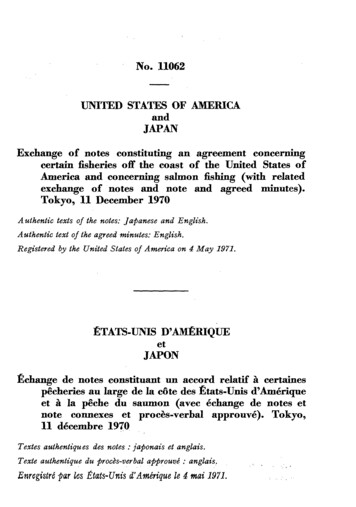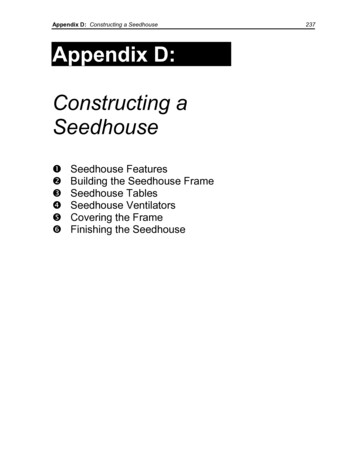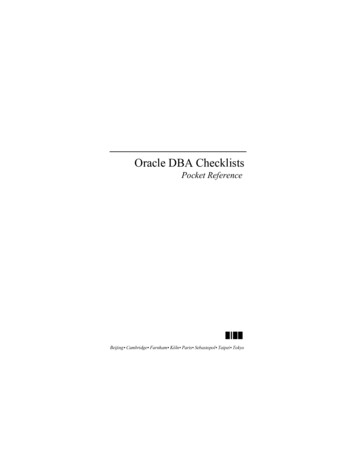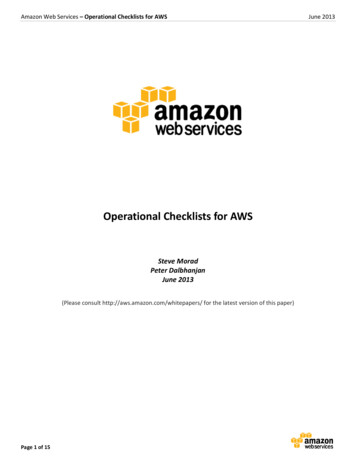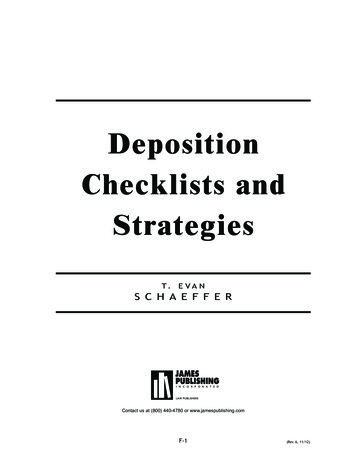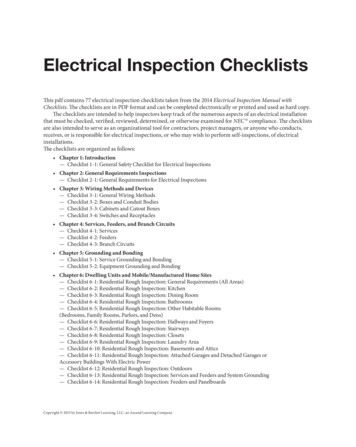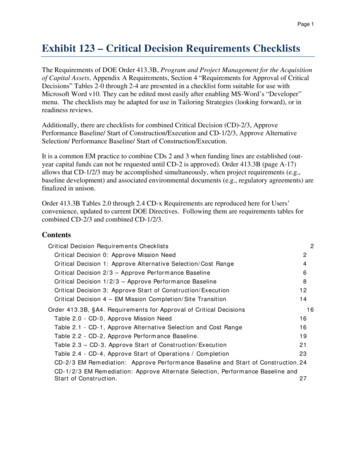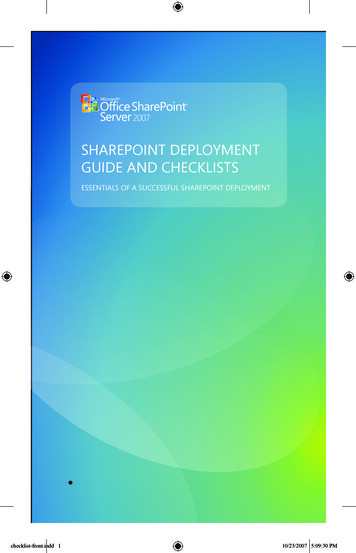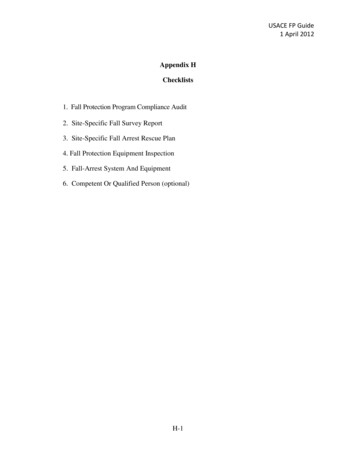
Transcription
USACE FP Guide1 April 2012Appendix HChecklists1. Fall Protection Program Compliance Audit2. Site-Specific Fall Survey Report3. Site-Specific Fall Arrest Rescue Plan4. Fall Protection Equipment Inspection5. Fall-Arrest System And Equipment6. Competent Or Qualified Person (optional)H-1
USACE FP Guide1 April 20121. FALL PROTECTION PROGRAM COMPLIANCEAUDIT CHECKLISTFALL PROTECTION PROGRAMDate of Audit:COMPLIANCE CHECK LIST FOR PERSONNEL PERFORMING WORK AT HEIGHTS,EXPOSED TO FALL HAZARDS AND USING FP EQUIPMENTProjectDistrictPrepared/Audited bySignatureFALL PROTECTION PROGRAM CRITERIA1Does the Project have personnel working at heights, exposed to fall hazardsabove 4 feet and using Fall Protection (FP) Equipment?Is there a possibility of a fall from any height onto dangerous equipment, into ahazardous environment or onto an impalement hazard? Is there any need todeviate from the 4 feet threshold requirement? Is this deviation approved by thedesignated Competent Person?If Yes, fall protection program is required to be established and implementedBASIC PROGRAM REQUIREMENTS2Is the fall protection program written and approved by the Project?3As an alternate to the written fall Protection Program, is the Project using the Fallprotection guide as their program with Safety Office approval?ADDITIONAL REQUIREMENTS4Is there a need for the Project to have additional requirements above and beyondthe requirements stated in this Guide?DUTIES AND RESPONSIBILITIES5Did the Project delineate duties and assigned responsibilities of personnelinvolved in the fall protection program, including Program Manager, Competentand Qualified Persons for fall protection, in the implementation of a managed fallprotection program?H-2YesNoN/A
USACE FP Guide1 April 20126Do the assigned personnel have the necessary skills, knowledge, training andexpertise to manage, administer, and implement the fall protection programsafely?WORKPLACE SURVEYS AND ASSESSMENT OF FALL HAZARDS7Has a survey been conducted for each fall hazard at existing buildings, facilitiesor structures and a Fall Hazard Survey Report prepared?8Was fall hazard analysis performed to determine the risk assessment, hazardseverity and fall mishap probability?9Are one or more fall protection methods identified in the survey report to eliminateor control each fall hazard?10Do the surveyed walking working surfaces have the structural integrity to safelysupport the workers (i.e. working on roofs)?11For personnel conducting roof inspections and, investigations, have they receivedproper training to conduct the work safely, prior to accessing the roof?FALL PROTECTION AND PREVENTION PLAN12For personnel exposed to fall hazards and using fall arrest equipment (nototherwise protected by passive fall protection system such as guardrails) has aSite Specific Fall Protection and Prevention Plan been prepared and submitted tothe Safety Office for review and approval?(It is recommended to prepare a generic fall protection and prevention plan fornon-routine tasks (i.e. emergency tasks)).The plan shall be updated as conditions change, once every six months.13Is the fall protection and prevention plan prepared either by the designatedcompetent or qualified person for fall protection?If the plan includes fall protection components or systems requiring direction,supervision, design calculations or drawings by the qualified person for fallprotection, the name, qualifications and responsibilities of the qualified personshall be addressed in the plan.14Does the plan describe in detail the specific practices, equipment, methods andprocedures to be used for the protection of workers from falling to lower level andthe inspection requirements?H-3
USACE FP Guide1 April 2012PREFERRED ORDER OF CONTROL MEASURES15Have the fall hazards been evaluated to determine the preferred order of controlmeasure for selecting the appropriate fall protection method (i.e. elimination orprevention)?16Can fall hazards be eliminated by alternate work methods or changing task(s) orprocess(s)?SELECTION OF FALL PROTECTION MEASURE17Is the most appropriate fall protection method selected, compatible with the typeof work being performed?STANDARD GUARDRAIL SYSTEM18If guardrails are used, do they comply with the specified requirements for height,strength and minimum material of construction?19If perimeter cables used at unprotected side or edge, as a method of attaching alanyard to the cables, do they meet the design requirements for horizontallifelines?Did the qualified person for fall protection design the system as a horizontallifeline system?COVERS20If covers are used to cover a hole 2 inches in its least dimension, are theycapable of withstanding without failure, at least twice the combined weight of theworker, equipment and material?When covers are used, are they clearly marked or color coded?WORK PLATFORMS21When working from elevated work platform, is the platform equipped withguardrail or other fall protection system? Is the work platform maintainedproperly?SAFETY NET SYSTEM22Does the safety net installation meet the specified criteria and requirements,including the size of the mesh openings and the strength of the outer rope orH-4
USACE FP Guide1 April 2012webbing?23Has the safety net been tested in suspended position immediately afterinstallation and under the supervision of qualified person?24If a safety net is relocated, repaired or left in place for more than 6 months, was itretested in suspension under the supervision of qualified person?25Is the inspection of the safety net performed by a competent person and inaccordance with manufacturer’s recommendations?26Inspection of safely nets shall be performed immediately after installation, weeklythereafter, and following any alteration or repair. Has the inspection beendocumented?PERSONAL FALL PROTECTION SYSTEMS27Do all the fall arrest systems and equipment used meet ANSI/ASSE Z359 FallProtection Code Standards?28When selecting personal fall protection system, are the free fall distance, total falldistance and available clearance taken into consideration?29Do the snaphooks and carabiners used meet ANSI Z359 Fall ProtectionCode/Standards?(Snaphooks and carabiners meeting ANSI Z359.1-1992 (R1999) shall not beused.)30For workers having body weight outside the capacity range of 130-310 lbs andusing fall protection equipment, is it permitted in writing by the manufacturer?31If it is necessary to increase the free fall distances beyond 6 feet (i.e. tying at thefoot level) and limiting the maximum arresting force on the body under 1,800 lbs,is the qualified person for fall protection making this determination?When the tie off point is located below the dorsal D-ring, use the 12 ft free fallenergy absorbing single or “y” lanyards. A qualified person for fall protection isrequired to make this determination.32If the Sternal D-ring attachment point of the body harness (located at thesternum) is used for fall arrest, is the worker exposed to a free fall distance ofless than two feet and the average arrest force on the body is 900 lbs?H-5
USACE FP Guide1 April 201233Self Retracting Devices (SRD) shall not be used in horizontal applications unlesspermitted by the manufacturer. Is the SRD used in vertical application?34When using “Y” lanyard for 100% tie-off, does the joint between the two legs ofthe lanyard withstand a force of 5,000 lbs?35The unused leg of the “Y” lanyard shall not be attached to any part of theharness, except to attachment points specifically designated by the manufacturer.Has the manufacturer of the equipment designated such attachment points?36When using positioning system, is the worker using a separate system(secondary system) that provides back-up protection from a fall?When using a restraint system, is the lanyard length short enough (or adjustable)to prevent a worker from being exposed to a fall hazard?37When using ladder climbing devices for ascending or descending on fixedladders, is the length of connection point between the body harness and the railor cable 9 inches or less?Will the system be activated within two feet after a fall occurs?Prior to installation, has the ladder to which the climbing device will attached to,been designed to withstand the forces generated by the fall of the climber?FALL ARREST EQUIPMENT SELECTION CRITERIA39Does the selected fall arrest equipment meet ANSI Z359 (2007) Fall ProtectionCode?(Any equipment meeting ANSI A10.14 shall not be used)40Can the manufacturer of the selected equipment substantiate thru Third-PartyTesting Laboratories, Witness Testing or Manufacturer Self- Certification Testingthat the equipment meets ANSI Z359 Fall Protection Code/Standards and/ordesigned, selected and approved by the qualified person for fall protection?TRAINING41Is all fall protection training for all personnel involved in the fall protectionprogram in accordance with the ANSI Z359 Fall Protection Code?42Are workers trained by a competent person for fall protection who is qualified todeliver the training on the safe use of fall protection and rescue equipment,including hands on and practical demonstrations?H-6
USACE FP Guide1 April 201243Did the assigned Competent and Qualified Persons for Fall Protection receiveadequate training?44Did other personnel involved in the fall protection program receive adequatetraining?45Has the above training been documented and verified with a certificate oftraining?46Did end users receive refresher/update training on the use of fall protectionequipment once every two years?Did the competent person for fall protection receive refresher/update training tostay current with the fall protection and educational requirements once every twoyears?Did other personnel involved in the fall protection program receive recommendedor required refresher/update training as specified in ANSI Z359.2 standard?SELECTION OF ANCHORAGES FOR FALL ARREST EQUIPMENT47For fall arrest anchorages selected/identified and designed by a qualified personfor fall protection, are they capable of supporting at least twice the maximumarresting force?For fall arrest anchorages selected by a competent person for fall protection, arethey capable of supporting a minimum force of 5,000 pounds per personattached?48For positioning and travel restraint anchorages selected by a competent personfor fall protection are they capable of supporting 3,000 pounds per employeeattached?If positioning and restraint anchorages selected and designed by a qualifiedperson for fall protection, do they meet the requirement of two times theforeseeable force on the worker?49Are the horizontal lifeline anchorages designed by a registered professionalengineer with experience in designing HLL systems; or designed by a qualifiedperson for fall protection who has appropriate training and experience?RESCUE PLAN AND PROCEDURESH-7
USACE FP Guide1 April 201250For personnel working at heights and using fall arrest equipment, has a sitespecific rescue plan and procedures been prepared and maintained at the worklocation?51If self-rescue or assisted-rescue are the planned methods to be used duringrescue, did personnel conducting rescue receive adequate training?52If required, are independent anchorages for rescue identified and selected?53If the method of rescue is by the jurisdictional public and Government-emergencyresponse agencies, has a pre-incident plan been developed?INSPECTION OF PERSONAL FALL PROTECTION EQUIPMENT54Have procedures been established for inspection, storage care and maintenanceof the equipment and IAW manufacturer’s instructions and recommendations?55Does the competent person for fall protection inspect the fall protectionequipment annually and w/documentation?56Does the end user inspect the equipment prior to each use?FALLS FROM HEIGHTS MISHAP REPORTING57Are falls from heights mishaps reported to the Safety Office?EVALUATION OF PROGRAM EFFECTIVENESS58Are procedures in place to audit and evaluate the fall protection program, at leastonce every two years?End of SectionH-8
USACE FP Guide1 April 20122. Site-Specific Fall Survey Report ChecklistGENERAL INFORMATIONProject:Date:Building/Facility #:Work Area:Survey Conducted By:Approved By:Fall Hazard # (1, 2, 3, etc.)FP Program Manager orCompetent Person:1SURVEY INFORMATIONMajor Fall Hazard Zoneor Type:Work Location:Personnel Interviewed:1.Guiding Regs:2.Work Type:EM 385-1-1, 29 CFR 1910 and1926, ANSI/ASME Z 3593.Location or Distance toObstructions (Ft)?Distance of Personnel from Fall Hazard (Ft):Suggested Anchorage(s) (if fall arrest system utilized):Distance to GroundBelow (Ft):Number of Personnel Exposed to FallHazard:Frequency/Duration of Fall Exposure:Potential Severity of Fall:/Exposure Risk:Severe InjuryAccess or Egress to Fall HazardArea (i.e. ladder, Stairs, WorkPlatform, Scissor Lift, etc.)HighObstructions in Fall Path:Condition of Floor/OtherSurfaces:LadderH-9Good
USACE FP Guide1 April 2012Historical Fall Mishaps at the Facility?UnknownLock Out/Tag Out Hazard?NoIs There a Risk of the Following?Suggested Fall Protection SolutionsHot Objects:Fall Arrest (FA) SystemSparks:Horizontal Life-LineFAPortable SystemType:Overhead Beam StrapFlames:Self-Retracting LanyardEnergy Absorbing LanyardChemical Hazards:Maintenance Stand or work platformsElectrical Hazards:Restraint SystemSharp Objects:Positioning SystemAbrasive Surfaces:Aerial Lift/Work PlatformsWeather Factor:Horizontal or Vertical Lifeline SystemOther risk Factors:Other FP methodsAnchorage(s) Locations (if Applicable)Can Rescue Be Performed IfRequired?Type of Rescue:Self or Assisted RescueCan Rescue be performed ifrequired? Or is there a rescue planprepared?UnknownExplain Other:Are End Users Trained on Fall ArrestSystems?UnknownDo Swing Fall HazardsExist?Additional InformationUnknownYesNote: For complete fall hazard survey of the facility, tabulate and develop summary of findings for alllocations.End of SectionH-10
USACE FP Guide1 April 20123. Site-Specif
01.04.2012 · (Any equipment meeting ANSI A10.14 shall not be used) 40 . Can the manufacturer of the selected equipment substantiate thru Third-Party Testing Laboratories, Witness Testing or Manufacturer Self- Certification Testing that the equipment meets ANSI Z359 Fall Protection Code/Standards and/or designed, selected and approved by the qualified person for fall protection? TRAINING . 41 . Is all fall .
